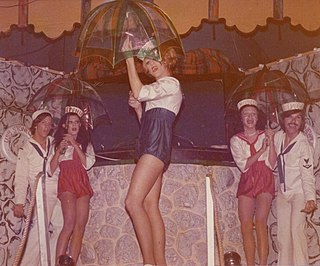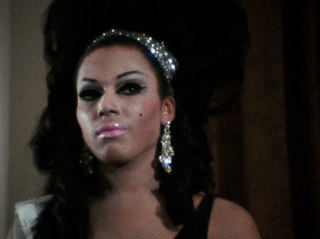
A drag queen is a person, usually male, who uses drag clothing and makeup to imitate and often exaggerate female gender signifiers and gender roles for entertainment purposes. Historically, drag queens have usually been gay men, and have been a part of gay culture.

In the United States and Canada, bingo is a game of chance in which each player matches the numbers printed in different arrangements on cards. The game host draws balls at random, marking the selected numbers with tiles. When a player finds that the selected numbers are arranged on their card in a horizontal, vertical, or diagonal line, they call out "Bingo!" to alert all participants to a winning card, which prompts the game host to examine the card for verification of the win. Players compete against one another to be the first to have a winning arrangement for the prize or jackpot. After a winner is declared, the players clear their number cards of the tiles and the game host begins a new round of play.
Drag is a performance of exaggerated femininity, masculinity, or other forms of gender expression, usually for entertainment purposes. Drag usually involves cross-dressing. A drag queen is someone who performs femininely and a drag king is someone who performs masculinely. Performances often involve comedy, social satire, and at times political commentary. The term may be used as a noun as in the expression in drag or as an adjective as in drag show.

Gay men are male homosexuals. Some bisexual and homoromantic men may dually identify as gay, and a number of gay men also identify as queer. Historic terminology for gay men has included inverts and uranians.

Vogue, or voguing, is a highly stylized, modern house dance originating in the late 1980s that evolved out of the Harlem ballroom scene of the 1960s. It is inspired by the poses of models in fashion magazines.

Paris Is Burning is a 1990 American documentary film directed by Jennie Livingston. Filmed in the mid-to-late 1980s, it chronicles the ball culture of New York City and the African-American, Latino, gay, and transgender communities involved in it.

A drag show is a form of entertainment performed by drag artists impersonating men or women, typically in a bar or nightclub. Shows can range from burlesque-style, adult themed nightclub acts to all-ages events with sing-alongs and story times.

The Pansy Craze was a period of increased LGBT visibility in American popular culture from the late-1920s until the mid-1930s. During the "craze," drag queens — known as "pansy performers" — experienced a surge in underground popularity, especially in Los Angeles, New York City, Chicago, and San Francisco. The exact dates of the movement are debated, with a range from the late 1920s until 1935.

William Roscoe Leake, better known as Willi Ninja, was an American dancer and choreographer known for his appearance in the documentary film Paris Is Burning.

The Harlem Renaissance was an intellectual and cultural revival of African American music, dance, art, fashion, literature, theater, politics and scholarship centered in Harlem, Manhattan, New York City, spanning the 1920s and 1930s. At the time, it was known as the "New Negro Movement", named after The New Negro, a 1925 anthology edited by Alain Locke. The movement also included the new African American cultural expressions across the urban areas in the Northeast and Midwest United States affected by a renewed militancy in the general struggle for civil rights, combined with the Great Migration of African American workers fleeing the racist conditions of the Jim Crow Deep South, as Harlem was the final destination of the largest number of those who migrated north.

The Ballroom scene is an African-American and Latino underground LGBTQ+ subculture. Its origins can be found in drag balls of the mid-19th century United States, such as those hosted by William Dorsey Swann, a formerly enslaved Black man in Washington D.C.. By the early 20th century, integrated drag balls were popular in cities such as New York, Chicago, New Orleans, Baltimore, and Philadelphia. In the mid-20th century, as a response to racism in integrated drag spaces, the balls evolved into house ballroom, where Black and Latino attendees could "walk" in a variety of categories for trophies and cash prizes. Most participants in ballroom belong to groups known as "houses," where chosen families of friends form relationships and communities separate from their families of origin, from which they may be estranged. The influence of ballroom culture can be seen in dance, language, music, and popular culture, and the community still exists today.

Pepper LaBeija was an American drag queen and fashion designer. She was known as "the last remaining queen of the Harlem drag balls".
"Kiki" is a term which started in ballroom culture and has recently been brought back to slang by the LGBTQIA+ community, is loosely defined as a gathering of friends for the purpose of gossiping and chit-chat, and later made more famous in the 2012 song "Let's Have a Kiki" by the Scissor Sisters.

The Grand United Order of Odd Fellows, American Jurisdiction is a jurisdiction of the Grand United Order of Oddfellows in the United States, Jamaica, Canada, South America, and other locations. Since its founding in 1843, its membership has principally included African Americans, due to their being discriminated against in most other fraternal orders in America at the time.

New York City has been described as the gay capital of the world and the central node of the LGBTQ+ sociopolitical ecosystem, and is home to one of the world's largest LGBTQ populations and the most prominent. Brian Silverman, the author of Frommer's New York City from $90 a Day, wrote the city has "one of the world's largest, loudest, and most powerful LGBT communities", and "Gay and lesbian culture is as much a part of New York's basic identity as yellow cabs, high-rise buildings, and Broadway theatre". LGBT travel guide Queer in the World states, "The fabulosity of Gay New York is unrivaled on Earth, and queer culture seeps into every corner of its five boroughs". LGBT advocate and entertainer Madonna stated metaphorically, "Anyways, not only is New York City the best place in the world because of the queer people here. Let me tell you something, if you can make it here, then you must be queer."

The African-American LGBT community, otherwise referred to as the Black American LGBT community, is part of the overall LGBT culture and overall African-American culture. The initialism LGBT stands for lesbian, gay, bisexual, and transgender.
Gay balls, cross-dressing balls or drag balls, depending on the place, time, and type, were public or private balls, celebrated mainly in the first third of the twentieth century, where cross-dressing and ballroom dancing with same sex partners was allowed. By the 1900s, the balls had become important cultural events for gays and lesbians, even attracting tourists. Their golden age was during the Interwar period, mainly in Berlin and Paris, even though they could be found in many big cities in Europe and the Americas such as Mexico City and New York City.

Crystal LaBeija was an American drag queen and trans woman who co-founded the House of LaBeija in 1968. The House is often credited as starting the house system in ball culture. She became a mother figure for homeless LGBTQ youth.
William Dorsey Swann was an American. An African-American born into slavery, Swann was the first person in the United States to lead a queer resistance group and the first known person to self-identify as a "queen of drag".















